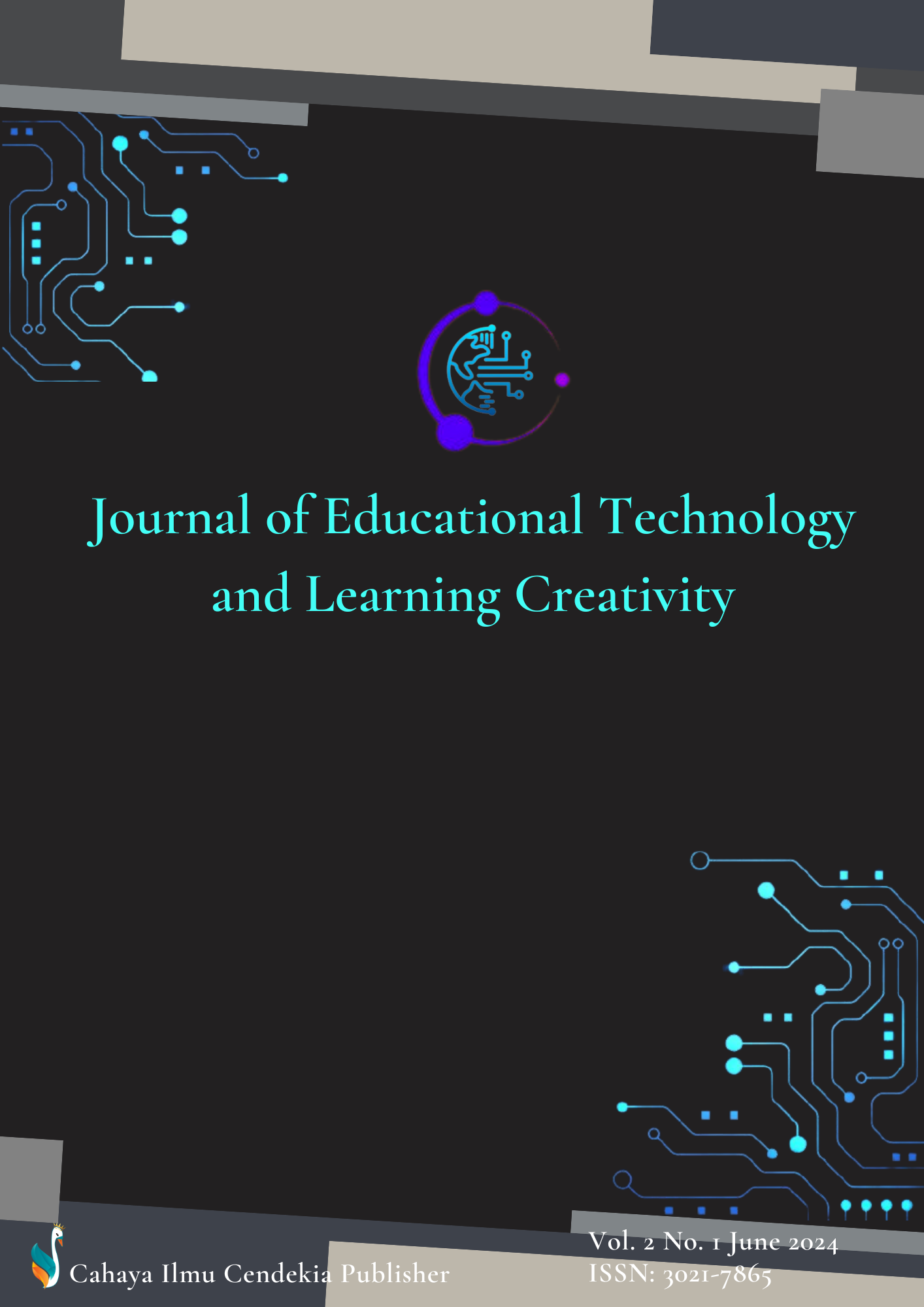Analysis of the Role of the Flo Application as a Digital Educational Media for Adolescent Reproductive Health in the Technology Era
Abstract
Purpose of the study: This study aims to analyze the role of the Flo application as a digital educational media based on AI in improving adolescent knowledge, attitudes, and behavior related to reproductive health in the era of modern technology.
Methodology: This study uses a qualitative approach with a descriptive analytical method to explore the experiences, perceptions, and impacts of using the Flo application on adolescents in the context of reproductive health education. Data were collected through in-depth interviews, questionnaires, observations, and documentation studies. The sampling technique used was purposive sampling, while data analysis was carried out with a thematic approach for qualitative data and descriptive statistics for quantitative data.
Main Findings: The results showed that the Flo app was effective in increasing adolescents' understanding of reproductive health, with the majority of respondents feeling more confident in managing their menstrual cycles and maintaining their health. The most appreciated features were cycle prediction and daily symptom logs. Although the app had a positive impact, there were obstacles such as limited access to premium features and difficult-to-understand medical terms. Overall, the Flo app was well received by users and showed potential for further development.
Novelty/Originality of this study: This study offers novelty by exploring the role of the Flo app that uses AI to predict menstrual cycles and provide personalized reproductive health education content. Unlike previous studies, this study leverages an app that is already widely available, opening up opportunities to develop a more relevant and effective digital education platform for adolescents.
References
S. R. Howard, “Interpretation of reproductive hormones before, during and after the pubertal transition—Identifying health and disordered puberty,” Clin. Endocrinol. (Oxf)., vol. 95, no. 5, pp. 702–715, 2021, doi: 10.1111/cen.14578.
A. Hegde, S. Chandran, and J. I. Pattnaik, “Understanding adolescent sexuality: a developmental perspective,” J. Psychosexual Heal., vol. 4, no. 4, pp. 237–242, 2022, doi: 10.1177/26318318221107598.
F. Mastorci, M. F. L. Lazzeri, C. Vassalle, and A. Pingitore, “The transition from childhood to adolescence: between ealth and Vulnerability,” Children, vol. 11, no. 8, pp. 1–15, 2024, doi: 10.3390/children11080989.
N. S. Punjani, E. Papathanassoglou, K. Hegadoren, S. Hirani, Z. Mumtaz, and M. Jackson, “Associations between developing sexuality and mental health in heterosexual adolescents: evidence from lower- and middle-income countries—a scoping review,” Adolescents, vol. 2, no. 2, pp. 164–183, 2022, doi: 10.3390/adolescents2020015.
F. Y. Gbagbo, E. K. Ameyaw, and S. Yaya, “Artificial intelligence and sexual reproductive health and rights: a technological leap towards achieving sustainable development goal target 3.7,” Reprod. Health, vol. 21, no. 1, 2024, doi: 10.1186/s12978-024-01924-9.
T. J. Ketye, G. B. Babatunde, S. Mianda, and O. Akintola, “Provider perspectives on adolescent access to contraception in South Africa,” African J. Prim. Heal. Care Fam. Med., vol. 16, no. 1, pp. 1–11, 2024, doi: 10.4102/PHCFM.V16I1.4537.
M. Janighorban, Z. Boroumandfar, R. Pourkazemi, and F. Mostafavi, “Barriers to vulnerable adolescent girls’ access to sexual and reproductive health,” BMC Public Health, vol. 22, no. 1, pp. 1–16, 2022, doi: 10.1186/s12889-022-14687-4.
P. Leekuan, R. Kane, P. Sukwong, and W. Kulnitichai, “Understanding sexual and reproductive health from the perspective of late adolescents in Northern Thailand: a phenomenological study,” Reprod. Health, vol. 19, no. 1, pp. 1–17, 2022, doi: 10.1186/s12978-022-01528-1.
A. Kågesten and M. van Reeuwijk, “Healthy sexuality development in adolescence: proposing a competency-based framework to inform programmes and research,” Sex. Reprod. Heal. Matters, vol. 29, no. 1, pp. 104–120, 2021, doi: 10.1080/26410397.2021.1996116.
R. Dimitrov, A. Jelen, and J. L’Etang, “Taboos in health communication: Stigma, silence and voice,” Public Relations Inq., vol. 11, no. 1, pp. 3–35, 2022, doi: 10.1177/2046147X211067002.
N. F. Mohd. Tohit and M. Haque, “Forbidden conversations: a comprehensive exploration of taboos in sexual and reproductive health,” Cureus, vol. 16, no. 8, 2024, doi: 10.7759/cureus.66723.
B. M. Ochieng et al., “Perspectives of adolescents, parents, service providers, and teachers on mobile phone use for sexual reproductive health education,” Soc. Sci., vol. 11, no. 5, 2022, doi: 10.3390/socsci11050196.
S. Goli, F. Rahimi, and M. Goli, “Experiences of teachers, educators, and school counselors about the sexual and reproductive health of educable intellectually disabled adolescent girls: a qualitative study,” Reprod. Health, vol. 19, no. 1, pp. 1–10, 2022, doi: 10.1186/s12978-022-01397-8.
J. Pyżalski, P. Plichta, A. Szuster, and J. Barlińska, “Cyberbullying characteristics and prevention—what can we learn from narratives provided by adolescents and their teachers?,” Int. J. Environ. Res. Public Health, vol. 19, no. 18, 2022, doi: 10.3390/ijerph191811589.
L. Verity, K. Yang, R. Nowland, A. Shankar, M. Turnbull, and P. Qualter, “Loneliness from the adolescent perspective: a qualitative analysis of conversations about loneliness between adolescents and childline counselors,” J. Adolesc. Res., vol. 39, no. 5, pp. 1413–1443, 2024, doi: 10.1177/07435584221111121.
M. M. Taye, “Understanding of machine learning with deep learning :,” Comput. MDPI, vol. 12, no. 91, pp. 1–26, 2023, doi: 10.3390/computers12050091.
A. Tlili et al., “Is Metaverse in education a blessing or a curse: a combined content and bibliometric analysis,” Smart Learn. Environ., vol. 9, no. 1, 2022, doi: 10.1186/s40561-022-00205-x.
R. Sajja, Y. Sermet, M. Cikmaz, D. Cwiertny, and I. Demir, “Artificial intelligence-enabled intelligent assistant for personalized and adaptive learning in higher education,” Information, vol. 15, no. 10, p. 596, 2024.
C. Papapicco, I. Lamanna, and F. D’errico, “Adolescents’ Vulnerability to Fake News and to Racial Hoaxes: A Qualitative Analysis on Italian Sample,” Multimodal Technol. Interact., vol. 6, no. 3, 2022, doi: 10.3390/mti6030020.
C. Almeida et al., “When does credibility matter? The assessment of information sources in teenagers navigation regimes,” J. Librariansh. Inf. Sci., vol. 55, no. 1, pp. 218–231, 2023, doi: 10.1177/09610006211064647.
J. Haider and O. Sundin, “Information literacy challenges in digital culture: conflicting engagements of trust and doubt,” Inf. Commun. Soc., vol. 25, no. 8, pp. 1176–1191, 2022, doi: 10.1080/1369118X.2020.1851389.
S. Shajari, K. Kuruvinashetti, A. Komeili, and U. Sundararaj, “The emergence of AI-based wearable sensors for digital health technology: a review,” Sensors, vol. 23, no. 23, pp. 1–36, 2023, doi: 10.3390/s23239498.
Z. Amiri et al., “The personal health applications of machine learning techniques in the internet of behaviors,” Sustain., vol. 15, no. 16, 2023, doi: 10.3390/su151612406.
L. Zhaunova et al., “Characterization of self-reported improvements in knowledge and health among users of Flo period tracking App: cross-sectional survey,” JMIR mHealth uHealth, vol. 11, 2023, doi: 10.2196/40427.
Y. A. Awoke and M. H. Zikargae, “Exploring the opportunities and challenges of social media use in teaching and learning processes at public universities in Ethiopia,” Cogent Educ., vol. 10, no. 2, 2023, doi: 10.1080/2331186X.2023.2277558.
N. Bogiannidis, J. Southcott, and M. Gindidis, “An exploration of the possible educational opportunities and the challenges at the intersection of the physical and digital worlds occupied by 10–14 year-old students,” Smart Learn. Environ., vol. 10, no. 1, 2023, doi: 10.1186/s40561-023-00246-w.
V. C. Dallinger et al., “Utilisation of Digital Applications for Personal Recovery Amongst Youth with Mental Health Concerns,” Int. J. Environ. Res. Public Health, vol. 19, no. 24, 2022, doi: 10.3390/ijerph192416818.
L. Stabler et al., “‘I probably wouldn’t want to talk about anything too personal’: A qualitative exploration of how issues of privacy, confidentiality and surveillance in the home impact on access and engagement with online services and spaces for care-experienced young peo,” Adopt. Foster., vol. 47, no. 3, pp. 277–294, 2023, doi: 10.1177/03085759231203019.
L. Neelakantan, D. Fry, L. Florian, and F. Meinck, “Adolescents’ experiences of participating in sensitive research: a scoping review of qualitative studies,” Trauma, Violence, Abus., vol. 24, no. 3, pp. 1405–1426, 2023, doi: 10.1177/15248380211069072.
T. Bouchard, P. Yong, and P. Doyle-Baker, “Establishing a gold standard for quantitative menstrual cycle monitoring,” Med., vol. 59, no. 9, pp. 1–13, 2023, doi: 10.3390/medicina59091513.
S. Ponzo et al., “Menstrual cycle-associated symptoms and workplace productivity in US employees: A cross-sectional survey of users of the Flo mobile phone app,” Digit. Heal., vol. 8, 2022, doi: 10.1177/20552076221145852.
T. Jain, O. Negris, D. Brown, I. Galic, R. Salimgaraev, and L. Zhaunova, “Characterization of polycystic ovary syndrome among Flo app users around the world,” Reprod. Biol. Endocrinol., vol. 19, no. 1, pp. 1–11, 2021, doi: 10.1186/s12958-021-00719-y.
R. Ali, Z. B. Gürtin, and J. C. Harper, “Do fertility tracking applications offer women useful information about their fertile window?,” Reprod. Biomed. Online, vol. 42, no. 1, pp. 273–281, 2021, doi: 10.1016/j.rbmo.2020.09.005.
A. Pichon, K. B. Jackman, I. T. Winkler, C. Bobel, and N. Elhadad, “The messiness of the menstruator: assessing personas and functionalities of menstrual tracking apps,” J. Am. Med. Informatics Assoc., vol. 29, no. 2, pp. 385–399, 2022, doi: 10.1093/jamia/ocab212.
S. Riley and K. Paskova, “A post-phenomenological analysis of using menstruation tracking apps for the management of premenstrual syndrome,” Digit. Heal., vol. 8, 2022, doi: 10.1177/20552076221144199.
E. Pearce et al., “Loneliness as an active ingredient in preventing or alleviating youth anxiety and depression: a critical interpretative synthesis incorporating principles from rapid realist reviews,” Transl. Psychiatry, vol. 11, no. 1, 2021, doi: 10.1038/s41398-021-01740-w.
A. C. Cunningham et al., “Efficacy of the Flo App in Improving Health Literacy, Menstrual and General Health, and Well-Being in Women: Pilot Randomized Controlled Trial,” JMIR mHealth uHealth, vol. 12, 2024, doi: 10.2196/54124.
A. D. Herlia and M. Andriansyah, “Sentiment analysis of FLO applications for women’s needs using the CNN and LSTM algorithms,” Eduvest - J. Univers. Stud., vol. 4, no. 5, pp. 4061–4078, 2024, doi: 10.59188/eduvest.v4i5.1182.
Risma Oktaria and Evi Martha, “Analysis the Use of Learning Media Reproductive Health Education Based on Android and Websites: Sistematic Review,” Media Publ. Promosi Kesehat. Indones., vol. 6, no. 12, pp. 2397–2404, 2023, doi: 10.56338/mppki.v6i12.4140.
F. A. Safira et al., “Penerapan aplikasi berbasis SMS, Game dan android dalam meningkatkan pengetahuan kesehatan reproduksi remaja: literatur review,” J. Manaj. Inf. Kesehat. Indones., vol. 10, no. 1, p. 86, 2022, doi: 10.33560/jmiki.v10i1.395.
E. Yustin, A. Wijanarka, and A. Ashari, “Efektivitas aplikasi android kesehatan reproduksi remaja terhadap perbaikan perilaku seksual pranikah di SMK X Yogyakarta,” JHeS (Journal Heal. Stud., vol. 4, no. 1, pp. 96–103, 2020, doi: 10.31101/jhes.1357.
H. S. Musa, M. Krichen, A. A. Altun, and M. Ammi, “Survey on blockchain-based data storage security for android mobile applications,” Sensors (Basel)., vol. 23, no. 21, pp. 1–30, 2023, doi: 10.3390/s23218749.
S. Barradell and A. Bell, Is health professional education making the most of the idea of ‘students as partners’? Insights from a qualitative research synthesis, vol. 26, no. 2. Springer Netherlands, 2021. doi: 10.1007/s10459-020-09998-3.
R. Alkadri and A. Fauzi, “Analysis of learning media in the development of flood-themed teaching materials for high school students,” J. Phys. Conf. Ser., vol. 1481, no. 1, 2020, doi: 10.1088/1742-6596/1481/1/012059.
L. S. Chernick et al., “A multi-media digital intervention to improve the sexual and reproductive health of female adolescent emergency department patients,” Acad. Emerg. Med., vol. 29, no. 3, pp. 308–316, 2022, doi: 10.1111/acem.14411.
Y. Shevchenko and U. D. Reips, “Geofencing in location-based behavioral research: Methodology, challenges, and implementation,” Behav. Res. Methods, vol. 56, no. 7, pp. 6411–6439, 2024, doi: 10.3758/s13428-023-02213-2.
D. Makwana, P. Engineer, A. Dabhi, and H. Chudasama, “Sampling methods in research: A review,” Int. J. Trend Sci. Res. Dev., vol. 7, no. 3, pp. 762–768, 2023, [Online]. Available: https://www.researchgate.net/publication/371985656
S. Raifman, M. A. DeVost, J. C. Digitale, Y.-H. Chen, and M. D. Morris, “Respondent-driven sampling: a sampling method for hard-to-reach populations and beyond,” Curr. Epidemiol. Reports, vol. 9, no. 1, pp. 38–47, 2022, doi: 10.1007/s40471-022-00287-8.
T. R. Rebullido, C. Gómez-Tomás, A. D. Faigenbaum, and I. Chulvi-Medrano, “The prevalence of urinary incontinence among adolescent female athletes: A systematic review,” J. Funct. Morphol. Kinesiol., vol. 6, no. 1, 2021, doi: 10.3390/jfmk6010012.
H. Ma and J. Li, “An Innovative method for digital media education based on mobile internet technology,” Int. J. Emerg. Technol. Learn., vol. 16, no. 13, pp. 68–81, 2021, doi: 10.3991/ijet.v16i13.24037.
Z. S. Lassi, E. G. Neideck, B. M. Aylward, P. H. Andraweera, and S. Meherali, “Participatory Action Research for Adolescent Sexual and Reproductive Health: A Scoping Review,” Sexes, vol. 3, no. 1, pp. 189–208, 2022, doi: 10.3390/sexes3010015.
Y. Fety, Lisnawati, and F. M. Said, “Sexual and reproductive health education based on android applications in high school adolescent,” Malaysian J. Med. Heal. Sci., vol. 20, pp. 119–124, 2024, doi: 10.47836/mjmhs.20.s8.16.
K. Y. Huang, M. Kumar, S. Cheng, A. E. Urcuyo, and P. Macharia, “Applying technology to promote sexual and reproductive health and prevent gender based violence for adolescents in low and middle-income countries: digital health strategies synthesis from an umbrella review,” BMC Health Serv. Res., vol. 22, no. 1, pp. 1–27, 2022, doi: 10.1186/s12913-022-08673-0.
E. S. Andika, H. D. Surjono, and S. B. Wahyono, “Android-Based Multimedia Development as a Media for Adolescent Reproductive Health Education,” in International Conference on Online and Blended Learning 2019 (ICOBL 2019) Android-Based, 2020, pp. 194–197. doi: 10.2991/assehr.k.200521.043.
Copyright (c) 2024 Ambra Hyskaj, Auliya Ramadhanti, Hira Farhan , Amenah Allaham, Mazen A. Ismail

This work is licensed under a Creative Commons Attribution 4.0 International License.
Authors who publish with this journal agree to the following terms:
- Authors retain copyright and acknowledge that the Journal of Educational Technology and Learning Creativity is the first publisher licensed under a Creative Commons Attribution 4.0 International License.
- Authors are able to enter into separate, additional contractual arrangements for the non-exclusive distribution of the journal's published version of the work (e.g., post it to an institutional repository or publish it in a book), with an acknowledgment of its initial publication in this journal.
- Authors are permitted and encouraged to post their work online (e.g., in institutional repositories or on their website) prior to and during the submission process, as it can lead to productive exchanges and earlier and greater citation of published work.


.png)


.png)
.png)
.png)












